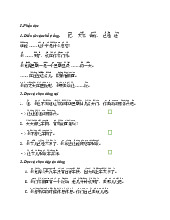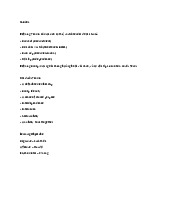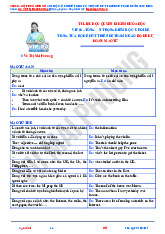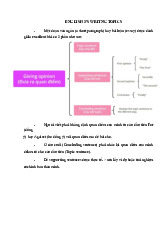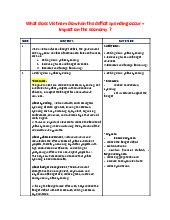


Preview text:
lOMoARcPSD|49830739
ACTION AND OUTCOMES OF RESEARCH CYCLE ONE 1. Planning stage
1.1 Identify the problem
The research was conducted to solve the problems about giving feedback on students’ writing
performance. They often covers every aspect/ area of language (such as grammar, content, lexico …)
in giving feedback on students’ written work. Teachers often give feedback in an inappropriate way
(unkind/ too general…) and they are not sure about whether their feedback can help students improve their writing. 1.2 Planning
Before conducting the study, the researchers had some English teachers do a survey to know
how they often give feedback on students’ writing performance.
Table 1.1 Purpose of feedback on students’ writing To help students To inform To show the improve their To give marks students about Total teacher’s knowledge writing their mistakes N % N % N % N % N % 45 95.7 17 36.2 26 55.3 5 10.6 47 100 Always Often Sometimes Rarely Never Total N % N % N % N % N % N % lOMoARcPSD|49830739 7 14,9 8 17,2 9 19,1 23 48,9 0 0 47 100
The table 1.1 shows that the majority of the teachers give feedback on students’ writing with
the purpose of helping students improve their writing. More than half of teachers assumed that they
gave feedback in order to inform students about their mistakes. Only 5 teachers would like to show
their knowlegde by giving feedback, accounting for 10,6% while there were 17 teachers gave marks
for students’ writing, representing 36,2%.
Table 1.2 Aspects of feedback on students’ writing Students’ weak Both students’ good Students’ good points points and weak T otal points (mistakes) points N % N % N % N % 3 6,4 38 80,8 6 12,8 47 100
Table 1.3 Aspects in the students’ writing that teachers focus feedback on
Both form focus The contents or Form focus Meaning focus and meaning ideas of students T otal focus writing N % N % N % N % N % 8 17 7 14,9 21 44,7 11 23,4 47 100
Table 1.4 Frequency of giving positive feedback to students’ writing
Table 1.5 Frequency of giving negative feedback to students’ writing Always Often Sometimes Rarely Never Total N % N % N % N % N % N % 25 53,2 10 21,3 8 17 3 6,4 1 2,1 47 100
Table 1.6 Frequency of asking students to write reflection about the feedback they received Always Often Sometimes Rarely Never Total N % N % N % N % N % N % 3 6,4 4 8,5 7 14,9 17 36,2 16 34 47 100
Table 2.1. I found my teacher’s feedback useful Strongly Neither agree Strongly Disagree Agree Total disagree nor disagree agree N % N % N % N % N % N % 3 1,5 6 3 34 17 101 50,5 56 28 200 100
Table 2.2. I liked the way my errors were corrected in this semester Strongly Neither agree Strongly Disagree Agree Total disagree nor disagree agree N % N % N % N % N % N % 2 1 11 5,5 20 10 106 53 51 25,5 200 100
Table 2.3. I felt comfortable in feedback sessions lOMoARcPSD|49830739 Strongly Neither agree Strongly Disagree Agree Total disagree nor disagree agree N % N % N % N % N % N % 5 2,5 6 3 31 15,5 107 53,3 51 25,5 200 100
Table 2.4. I hope that my English teacher will continue to use this approach to teach English next semester. Strongly Neither agree Strongly Disagree Agree Total disagree nor disagree agree N % N % N % N % N % N % 4 2 5 2,5 24 12 92 46 75 37,5 200 100
